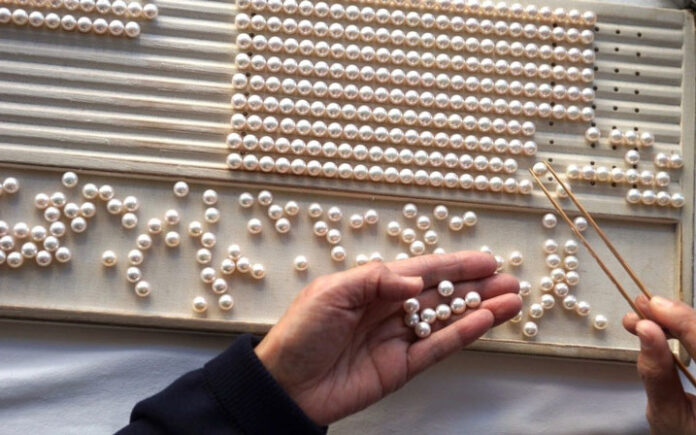The word ‘pearl’ becomes the identity of Hyderabad as it called pearl city of Hyderabad due to the extensive pearl trade by Arabs and Moghuls in entire south asia. Hyderabad is considered the main pearl trading centre in India, because of which the city is also known as the “City of Pearls”. The most notable area devoted to the trade is the village called Chandanpet just outside Hyderabad, wherein almost the entire population is engaged in the delicate art of drilling pearls, a skill they have practiced for generations. This practice also makes the city one of the largest pearl drilling locations in India.
In the nineteenth century, one of Hyderabad’s most treasured trade items was the pearl, which is connected to the moon. Approximately 4,000 to 5,000 pearls, ranging in colour from dark cream to yellowish pink and, of course, the valuable white pearls caught in the Persian Gulf, were imported into Hyderabad markets during the “pearl boom” years (1850 to 1930). Every pearl in the world, it was allegedly stated, “goes through Hyderabad at least once in its life.” This remark makes clear the extent of the pearl’s connection to Hyderabad.
For decades, Hyderabad’s pearl trade flourished under the Qutb Shahis and Asaf Jahi Nizams. Since the reign of the Qutb Shahis, Hyderabad had been recognised to receive pearl trade. Dried fruits, dates, dyes, silks, and pearls were just a few of the many goods that the Persians brought to Hyderabad.
The Nizams developed became the top customers for Basra pearls, a kind of pearl. They were reported to have even crushed these pearls to utilise them in cosmetic lotions. They were known to wear strands of Basra pearls embellished with other valuable stones as part of their ceremonial clothing. The majority of Hyderabad’s royal women wore numerous pearl necklaces, and they occasionally even had their birthdays weighed in favour of them. As the seventh Nizam of Hyderabad, Mir Osman Ali Khan was known to have stored Basra pearls in humble sacks in the basement of his palaces.
What was it about the Basra pearl in particular that made it the Nizams’ and the nobility’s most cherished property in Hyderabad?
The city of Basra in contemporary Iraq was the source of the Basra pearls that flooded the Indian markets. The Persian Gulf was a fantastic location for finding pearls, and its international trade was a moneymaker that only stopped with the discovery of oil. The city of Basra was a busy market where the pearl trade was growing, and the Persian Gulf was home to pearls of the most legendary quality. The pearls’ name was not given to them because they were discovered there, but rather because of the commercial hub. The Basra pearls were the only pearls discovered in the Persian Gulf region, including Bahrain, Kuwait, Oman, United Arab Emirates, etc.
The Princely States of Kashmir, Hyderabad, Gwalior, Mysore, and Baroda—the primary purchasers of Basra pearls in India—were likely unaware of the precise origin of the pearls they were purchasing. The term “Basra pearl” was used to refer to all Persian Gulf pearls together. The market, not the goods, is what made Basra’s commercial hub famous across the world.
The names or villages of merchants who carried their wares aboard English vessels are typically mentioned in the Basra factory records that have been cited by several authors. According to certain records of ship’s cargo lists, Jews were in charge of delivering Basra pearls to Surat because Indian traders from Surat were actively involved. in trade with Basra and the Gulf. Vessels owned by Armenian merchants also operated regularly between the Persian Gulf and India carrying Basra pearls. The Jews and Armenians through their business acumen found a legitimate place in Hyderabad’s society.
Thus, under the patronage of Hyderabad’s royalty, pearl merchants from all over flocked to the city to sell their wares making the resplendent Basra pearls a pride in the famed Nizam’s jewels collection. John Zubrzycki in his book The Mysterious Mr Jacob: Diamond Merchant, Magician and Spy says that Mir Osman Ali Khan, the seventh Nizam, designated as the richest man in the world, during the pearl boom period owned Basra pearls the size of a quail’s egg.
Earlier, pearl merchants used to sell the commodity directly to connoisseurs in the stately palaces and havelis of Hyderabad and Secunderabad, later traditional jewellery shops came up in the Charminar market area. Kevin Rushby in his book Chasing the Mountain of Light describes the common sights at these shops of short wooden ladders at the entrances, customers sitting on cushioned floors resting their elbows on bolsters, and shopkeepers sitting in front of them holding great ropes of shimmering pearls from small aluminum suitcases, are part of the nostalgic charm of Hyderabad.
The Nizams’ love for Basra pearls led to a whole industry for sorting, drilling, and polishing pearls in Hyderabad. There were specially trained artisans employed by several leading pearl traders in Hyderabad for surface cleaning of pearls by subjecting them to a treatment to improve their shine.
Drilling and polishing have now become a dying art with drilled, polished, graded, and ready-to-be-sold pearls from China and Japan flooding Hyderabad markets. Thus under the Nizams, Basra pearls became a craze and a trend in many aristocratic households.
Many Hyderabadis still have large collections of pearls that they cherish as family heirlooms. These pearls are carefully preserved and cared for by following the customary method of cleaning pearls with fine muslin and a small amount of sweat. The pearl trade thrived in Hyderabad for centuries under the royal patronage.#KhabarLve #hydnews #hydlive
(About the author: Salma Ahmed Farooqui is working as Director, H.K.Sherwani Centre for Deccan Studies at Maulana Azad National Urdu University in Hyderabad.)







